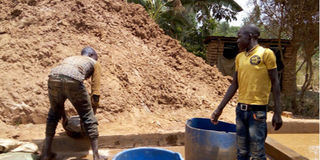New report raises alarm over use of mercury in gold mining

Artisanal miners in Tiira Village in Busia District pun gold from mud on February 23, 2019. Miners have continued to use mercury to extract gold despite the health complications it poses. PHOTO | DAVID AWORI
A report from Resource Rights Africa (RRA), an advocacy and rights organisation, shows that the use of mercury in artisanal gold mining (ASGM) in Karamoja Sub-region has left devastating effects on the miners’ health and the environment.
The report titled ‘Use of Mercury in Artisanal Gold Mining in Karamoja Sub- region’ , which was carried out in Moroto, Nakapiripirit, Amudat, Busia and Kampala districts in March 2022, shows that 80 percent of the gold miners in Karamoja use mercury, which is ranked third on the list of toxic substances.
During the release of the report in Kampala on Tuesday, Mr Richard Katongole, one of the researchers, said the gold miners pour mercury in the ore, which amalgamates the gold. The crushed ore is then washed over the plates in a slurry, which makes gold particles stick to the mercury.
“In this process of getting the gold, there is burning of the ore on which the mercury is poured and during the process, mercury vapour evaporates in the air and the gold miners inhale it, and even those that are not mining get into contact with the contaminated air,” Mr Katongole said.
He said mercury affects the nervous system, the functioning of the brain, causes long-life disability, miscarriages among women, death of cattle, and if inhaled in higher doses, kills instantly. The substance is also toxic to ecosystems, aquatic life and wildlife, he explained.
The researcher added that the gold miners opt for mercury because it is cheap and easy to use.
The report also further blamed the increase in the use of mercury in mining in Karamoja on the mobility of the miners.
“Mercury use in gold mines has been increasing following the migration nature of the artisanal miners. For example, mercury use in Karamoja was not as rampant as it is today until a good number of the miners shifted from other parts of Uganda such as Mubende, Buhweju, and Busia to Karamoja. Busia gold mines have been using mercury since 2008 but most mines in Karamoja were introduced to mercury use less than five years ago,” reads the report.
Mr Andrew Byaruhanga, the executive director of Resource Rights Africa, said the government’s Directorate of Geological Surveys and Maps knows about the danger mercury poses to human health but lacks the capacity to inspect the different mines.
“I advise the government to adopt the use of borates in mining, which our neighbours in Tanzania use. There has been no effort by the government to bring in this technology as a substitute for mercury since it is a safe method of gold mining,” he said.
Mr Moris Tabaro from the Department of Geological Surveys and Maps said whereas they are laws in place that govern the mining sector , most of them are not followed.
“There is a new law on mining that is coming up and it is stronger than the previous one and it is coming out soon, so we as government are surely working strongly to eliminate these issues,” Mr Tabaro said.
Mr Tabaro also urged natural resource officers to play their roles in sensitisation of the community members about the dangers of using mercury.
Intervention
The Minamata Convention on Mercury in October 2013 was adopted, which spells out targets to phase out the manufacture, export or import of a number of mercury-added products specified in the convention.
Uganda is a signatory to the Minamata Convention and has already developed legal frameworks to facilitate the phase-out of mercury. But beyond laws and policies that have been tucked away on shelves, mercury use continues to thrive.





